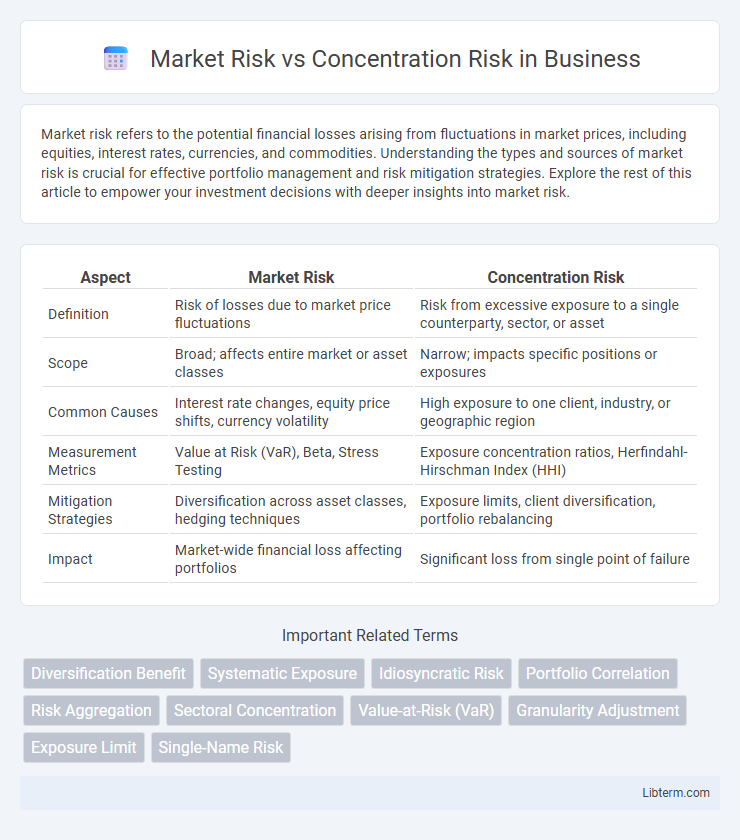Market risk refers to the potential financial losses arising from fluctuations in market prices, including equities, interest rates, currencies, and commodities. Understanding the types and sources of market risk is crucial for effective portfolio management and risk mitigation strategies. Explore the rest of this article to empower your investment decisions with deeper insights into market risk.
Table of Comparison
| Aspect | Market Risk | Concentration Risk |
|---|---|---|
| Definition | Risk of losses due to market price fluctuations | Risk from excessive exposure to a single counterparty, sector, or asset |
| Scope | Broad; affects entire market or asset classes | Narrow; impacts specific positions or exposures |
| Common Causes | Interest rate changes, equity price shifts, currency volatility | High exposure to one client, industry, or geographic region |
| Measurement Metrics | Value at Risk (VaR), Beta, Stress Testing | Exposure concentration ratios, Herfindahl-Hirschman Index (HHI) |
| Mitigation Strategies | Diversification across asset classes, hedging techniques | Exposure limits, client diversification, portfolio rebalancing |
| Impact | Market-wide financial loss affecting portfolios | Significant loss from single point of failure |
Understanding Market Risk and Concentration Risk
Market risk involves the potential for financial losses due to fluctuations in market prices, interest rates, and exchange rates, impacting portfolios exposed to diverse asset classes. Concentration risk arises from overexposure to a single counterparty, sector, or geographic region, increasing vulnerability to adverse events affecting that specific segment. Understanding both risks is crucial for implementing effective diversification strategies and ensuring robust risk management frameworks.
Key Differences Between Market Risk and Concentration Risk
Market risk refers to the potential for losses due to fluctuations in market prices, interest rates, or currency exchange rates affecting a broad portfolio, while concentration risk arises from heavy exposure to a single asset, sector, or counterparty, increasing vulnerability to specific events. Market risk impacts diverse investments across various asset classes, measured using metrics like Value at Risk (VaR) and Beta, whereas concentration risk focuses on the risk of unsystematic losses linked to lack of diversification. Effective risk management strategies differentiate by addressing market volatility through hedging and diversification, while concentration risk is mitigated by limiting exposure to individual positions or sectors.
Factors Influencing Market Risk
Market risk is influenced by factors such as interest rate fluctuations, currency exchange volatility, and equity price movements, which directly impact the value of financial instruments. Economic indicators, geopolitical events, and market liquidity also significantly affect market risk by altering investor sentiment and asset prices. Understanding these factors helps investors and institutions develop strategies to mitigate potential losses in dynamic market conditions.
Causes and Consequences of Concentration Risk
Concentration risk arises from excessive exposure to a single counterparty, sector, or geographic region, leading to potential significant losses if that specific area underperforms or faces distress. This risk results in reduced diversification, making portfolios more vulnerable to idiosyncratic shocks such as defaults, market downturns, or geopolitical events. The consequences include heightened volatility, impaired liquidity, and increased likelihood of systemic failures within financial institutions or investment funds.
Measuring Market Risk: Common Metrics and Tools
Measuring market risk involves quantitative metrics such as Value at Risk (VaR), which estimates potential losses over a specified period under normal market conditions, and Stress Testing to evaluate impacts under extreme scenarios. Other essential tools include Expected Shortfall (ES), which assesses average loss beyond the VaR threshold, and Beta, measuring an asset's sensitivity to overall market movements. These metrics provide actionable insights for risk managers to monitor, control, and hedge market exposure effectively.
Identifying and Assessing Concentration Risk
Concentration risk occurs when a financial portfolio or institution has excessive exposure to a single counterparty, sector, or geographic region, increasing the potential for significant losses. Identifying concentration risk requires analyzing exposure distribution through metrics like the Herfindahl-Hirschman Index and stress testing for adverse scenarios affecting concentrated segments. Assessing concentration risk involves continuous monitoring of correlations within asset classes and adjusting risk limits to maintain diversification and mitigate systemic vulnerabilities.
Impact of Market Risk on Investment Portfolios
Market risk, driven by factors such as interest rate fluctuations, currency volatility, and stock price movements, directly affects the value and returns of investment portfolios by causing unpredictable losses. Concentration risk, arising from excessive exposure to a single asset or sector, amplifies portfolio vulnerability but is a subset of overall market risk. Effective portfolio diversification and risk management strategies are essential to mitigate the adverse impact of market risk and safeguard long-term investment performance.
Mitigation Strategies for Concentration Risk
Mitigation strategies for concentration risk include diversifying investments across multiple asset classes, sectors, and geographies to reduce exposure to a single source of risk. Implementing strict portfolio limits and setting thresholds for individual positions help control overconcentration in specific securities or counterparties. Regular stress testing and scenario analysis enable early identification of vulnerabilities, allowing for proactive risk management and adjustment of concentration levels.
Integrating Market and Concentration Risk Management
Effective integration of market risk and concentration risk management enhances the identification and mitigation of vulnerabilities within investment portfolios and trading books. Leveraging advanced analytics and real-time data, firms can monitor correlated exposures across asset classes, sectors, and geographies to prevent overexposure to market shocks. Implementing comprehensive risk frameworks that combine stress testing, scenario analysis, and capital allocation ensures resilient portfolio performance under diverse market conditions.
Best Practices for Balanced Risk Exposure
Market risk management involves diversifying asset classes and using hedging instruments such as options and futures to mitigate potential losses from market fluctuations. Concentration risk requires monitoring portfolio allocation to avoid excessive exposure to a single sector, issuer, or geographic region, employing limits and periodic stress testing for balanced risk distribution. Implementing integrated risk frameworks and leveraging quantitative models enhances the detection of overlapping risks, ensuring resilient and optimized risk-adjusted returns.
Market Risk Infographic

 libterm.com
libterm.com